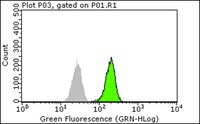05-1321 Sigma-AldrichAnti-BMI1 Antibody, clone AF27
Anti-BMI1 Antibody, clone AF27 is a mouse monoclonal antibody for detection of BMI1 also known as BMI1 polycomb ring finger oncogene, murine leukemia viral (bmi-1) oncogene homolog & has been validated in IP, ChIP.
More>> Anti-BMI1 Antibody, clone AF27 is a mouse monoclonal antibody for detection of BMI1 also known as BMI1 polycomb ring finger oncogene, murine leukemia viral (bmi-1) oncogene homolog & has been validated in IP, ChIP. Less<<Recommended Products
Przegląd
| Replacement Information |
|---|
Tabela kluczowych gatunków
| Species Reactivity | Key Applications | Host | Format | Antibody Type |
|---|---|---|---|---|
| H | IP, ChIP | M | Purified | Monoclonal Antibody |
| References |
|---|
| Product Information | |
|---|---|
| Format | Purified |
| Control |
|
| Presentation | Purified mouse monoclonal in buffer containing 0.1 M Tris-Glycine (pH 7.4), 150 mM NaCl with 0.05% sodium azide. |
| Quality Level | MQ100 |
| Physicochemical Information |
|---|
| Dimensions |
|---|
| Materials Information |
|---|
| Toxicological Information |
|---|
| Safety Information according to GHS |
|---|
| Safety Information |
|---|
| Storage and Shipping Information | |
|---|---|
| Storage Conditions | Stable at 2-8°C for 1 year from date of receipt. |
| Packaging Information | |
|---|---|
| Material Size | 100 µg |
| Transport Information |
|---|
| Supplemental Information |
|---|
| Specifications |
|---|
| Global Trade Item Number | |
|---|---|
| Numer katalogowy | GTIN |
| 05-1321 | 04053252408649 |
Documentation
Anti-BMI1 Antibody, clone AF27 MSDS
| Title |
|---|
Anti-BMI1 Antibody, clone AF27 Certificates of Analysis
| Title | Lot Number |
|---|---|
| Anti-BMI1, clone AF27 | 3082033 |
| Anti-BMI1, clone AF27 - 2430415 | 2430415 |
| Anti-BMI1, clone AF27 - 1941606 | 1941606 |
| Anti-BMI1, clone AF27 - 2023198 | 2023198 |
| Anti-BMI1, clone AF27 - 2262738 | 2262738 |
| Anti-BMI1, clone AF27 - NG1681858 | NG1681858 |
| Anti-BMI1, clone AF27 - NG1740996 | NG1740996 |
| Anti-BMI1, clone AF27 - NG1829872 | NG1829872 |
| Anti-BMI1, clone AF27 - NG1853779 | NG1853779 |
| Anti-BMI1, clone AF27 - NRG16443470 | NRG16443470 |








